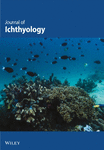Comparative survival and growth of embryos, larvae, and juveniles of pejerrey Odontesthes bonariensis and O. hatcheri* at different salinities
Formerly atagonina hatcheri.
Summary
The hatching of fertilized eggs and the survival and growth of larvae and juveniles of the inland-water atherinids Odontesthes bonariensis (Valenciennes 1835) and O. hatcheri (Eigenmann 1909) were examined at salinities of 0, 5, 10, 20, and 30 ppt. In addition, a limited study compared the salinity responses of O. bonariensis eggs and larvae from different origins. Overall, embryos, larvae, and juveniles of both species were euryhaline, although best survival and growth rates were obtained at the intermediate salinities. Survival of O. bonariensis at 0 ppt varied from very good to very poor. Comparison of the salinity responses of eggs and larvae of O. bonariensis from the current Japanese strain with newly introduced strains from three locations in Argentina did not reveal a clearly superior strain for freshwater culture. In general, O. hatcheri showed higher survival and growth rates and better adaptability to fresh water compared with O. bonariensis. Although both species are commonly regarded as freshwater species, the results of this study emphasize the importance of millimolar quantities of salts in the rearing water for improved survival and growth.




